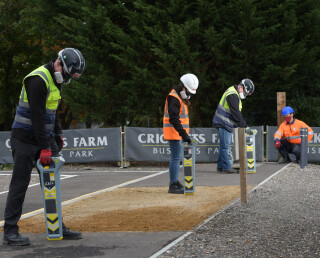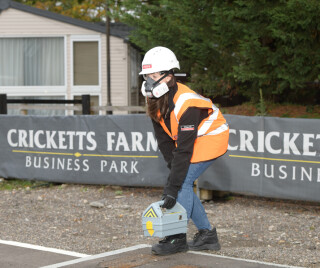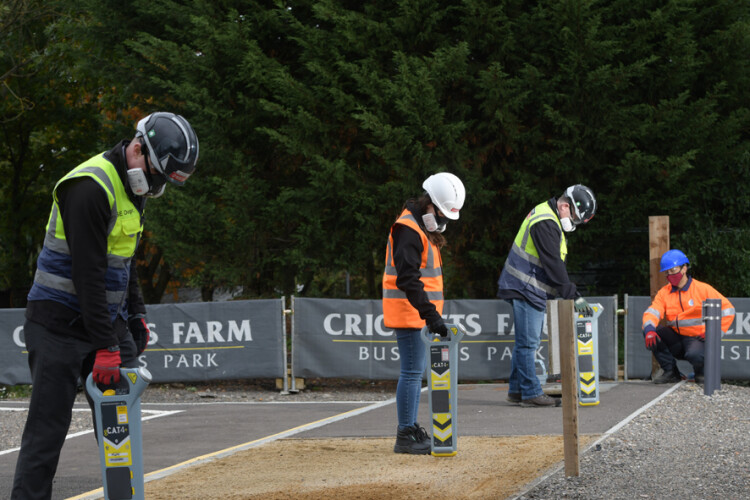When you’re digging up the ground or busting out concrete with a hand-held breaker, the last thing you want is to hit a live power cable because if you do, you’re likely to be badly injured or even killed.
Cable-strikes, as they’re known in the industry, are a common hazard, especially in streetworks where buried services tend to cluster along the route.
It’s not just power cables that pose a risk. Hitting a gas main or high-pressure water main can also prove catastrophic and severing a telecommunication cable will create mayhem for local users.
Worryingly, the incidence of cable-strikes appears to be on the rise. According to the Energy Networks Association (ENA), the body representing gas and electricity distribution licence-holders, in the past five years 354 people have suffered life-changing injuries from ‘arc-flash’ as a result of striking a live underground electricity cable.
This article was first published in the Oct/Nov 2020 issue of The Construction Index magazine. Sign up online.
And data published recently by the Health & Safety Executive (HSE) reveal that incidents of cable-strikes have increased by 46% since the national lockdown. Between July and September 2020, there were 475 reports of cable damage on work-sites, compared with 395 for the same period last year.
A survey conducted on behalf of the ENA indicates that the main cause of cable-strikes is both a lack of understanding of the risks and inadequate knowledge of correct procedure by those working on site. Few will be surprised to hear that, least of all Lucian d’Arco, group health, safety & environment leader with civil engineering contractor O’Keefe.
D’Arco joined O’Keefe in April 2019 from Careys Civil Engineering where he was health & safety manager. The year before that, O’Keefe had recorded a worrying increase in cable-strikes, with 14 incidents including one which ruptured a live gas main requiring the entire site to be evacuated. January 2019 saw another incident – by which time chief executive Patrick O’Keefe had decided that a new approach was needed.
“Patrick asked me to systematically review the group’s entire cable avoidance procedure and the training around it,” says d’Arco. “He wanted to increase awareness of the risks and improve the health and safety capabilities of those involved in utility excavations.”
One common misconception about cable-strikes is that they only occur during streetworks excavations. “But you’d be surprised,” says d’Arco. “You could have a football pitch in the middle of nowhere and think ‘yeah, no problem’, start digging only to find a cable or pipework from the 1950s that wasn’t on the plans you’d been given.”
There are well-established rules and guidance on the detection and avoidance of buried services, the most important being PAS128 – Specification for Utility Surveys, which is published by BSI and guidance note HSG47 – Avoiding Danger from Underground Services, published by the HSE.
O’Keefe, like many other contractors, has its own company handbook containing bespoke documents, such as rules for excavation around underground utilities and permits to dig, developed in line with the statutory documents. But with cable-strikes actually increasing in frequency, the message was clearly not getting through.

There is no lack of training available on the market for safe excavation best practice; but d’Arco thinks it’s mostly too theoretical and lacks sufficient depth to really make a difference on site. “A lot of it is outsourced, too,” he says. “Most of the external [training providers] don’t actually deliver the activity themselves – they’re just delivering a course,” he says.
In his previous role with Careys, d’Arco had worked closely with a company called Construction Skills Training Academy (CSTA) Global, and its founder, Ed Tai. Now at O’Keefe and with a remit to carry out a root-and-branch review of health & safety training, d’Arco brought Tai on board with a view to developing a completely new training course.

The result is an NVQ Level 2 qualification in Utility Avoidance & the Location of Buried Services.
The first stage was to compile a classroom-based training syllabus that covered all the relevant aspects of safe excavation around live utility services. “The course covers published guidance, regulations and legislation; how to read service drawings; understanding control measures around service isolation; procedures for contacting service owners; CDM compliance; practical use of CAT and genny equipment and the limitations of electro-magnetic locators,” explains d’Arco.
The CAT (Cable Avoidance Tool) & genny (signal generator) is the main weapon in the site operative’s armoury but it is often misused and its functions and limitations widely unappreciated, says d’Arco.
D’Arco’s main innovation was to add a second, practical, module to his training package, allowing trainees to put their classroom theory into practice under safe, controlled conditions.
Careys (d’Arco’s previous employer) had set up a training facility at its depot in Milton Keynes that included an aggregate-filled trench with a couple of cables running through it on which trainees could practise their cable-detection skills. “It was a good idea, but very basic,” says d’Arco. “Ed and I thought we could do better.”
Consequently, d’Arco and Tai drew up basic plans for a practical cable-detection training facility that would – as far as possible – replicate actual real-life site conditions.
Together, d’Arco and Tai designed a replica streetscape incorporating reconstructions of as many of the common features found in buried utility installations as possible. “It’s basically a mock road next to a pavement with inspection chambers, ducts etc,” says d’Arco.
“The first third of the trench is pretty straightforward; then there’s a section for safe digging, where the guys can learn how to excavate around a cable correctly; then in the third section we threw in a few curve-balls – like pieces of legacy metal to confuse them, and we made the cables a little more wiggly so they’d have to pay attention when marking them out, and we made it so we can change the side the current flows through so it isn’t always the same,” d’Arco explains.
D’Arco then took his plans to Patrick O’Keefe and asked for a few square metres of land on which to build his mock-road (complete with road-sign reading: What-if Way). O’Keefe obliged with a location at the company’s Kent depot in Borough Green.
The training facility was built earlier this year, during lockdown, and inaugurated with a series of training sessions for invited personnel from O’Keefe’s extended supply chain in early September. Representatives from clients including Wates, Willmott Dixon, Quintain, ISG, BAM and Caledonian Modular responded with enthusiasm, says d’Arco.
One attendee, Martin Glover, SHE manager with Wates Residential, was moved to congratulate d’Arco on the ‘outstanding’ course:
“As a result we have upgraded one of our ‘Bold Commitments’ namely avoiding buried services. I have attended several similar courses over the last 20 years yet yours was by a country mile the most useful and professional particularly the bespoke practical training area,” he wrote.
This article was first published in the Oct/Nov 2020 issue of The Construction Index magazine. Sign up online.

Got a story? Email news@theconstructionindex.co.uk



